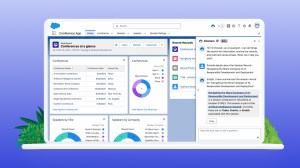You’ve likely heard the term “citizen developer” but might not understand exactly what it means, or how companies are embracing it. A citizen developer is a nontechnical user of a tech platform who — empowered by increasingly low-code development tools — is able to actually create and modify business applications. With Forrester predicting the U.S. economy will suffer a gap of 500,000 developers by 2024, these citizen developers seem well-positioned to fill a rapidly growing IT skills gap. Indeed, 74 percent of IT leaders plan to shift some of their application development to business units, according to a recent research study.
We spoke with David Riggan and Sudheer Sura — who run solutions delivery and the Salesforce practice, respectively, at American technology company BMC — about citizen development and its impact on business.
Q: A recent research study found that 52 percent of IT leaders say skills gaps are a major challenge at their organization. Why do you at BMC feel that citizen development can help bridge those gaps?
David: Well, there has always been a supply-versus-demand issue in IT. In short, there never seems to be enough supply to meet demand. And as we’re moving into this Fourth Industrial Revolution, this need to be ever more adaptable and flexible has exacerbated an already difficult situation. To put it simply, IT hasn’t been able to keep up with the pace of demand and pace of change.
That means that in a long list of IT priorities, if something isn’t high enough up that list, it simply doesn’t get done.
And that means that creative people out there go try to create these things themselves. That might be with Excel, that might be in an Access database. It might even be a manual paper process.
That’s often called “shadow IT” — and has been seen as a bad thing, something to avoid.
But shadow IT and citizen development are two sides of the same coin. Citizen development means enabling non-developers to do some development — in other words, to start ticking off other items on IT’s long list of priorities. It means I can now take a team of 15 developers, and I can turn those into 100 quasi-developers.
From our point of view, we launched a citizen development strategy at BMC because we have latent talent in our organization that can help us be more productive, responsive, and innovative in IT. Unleashing that talent seemed to be the best way to innovate and be productive at the level the Fourth Industrial Revolution demands.
Q: You talk about the need for a governance structure around citizen development. Why is that governance important, and what does that structure look like at BMC?
Sudheer: Like David said,many IT departments are running as fast as they can just to keep the lights on. But they’re scared to implement a citizen development strategy — something that might give them capacity to do more than just keep those lights on — because they’re worried it might break their enterprise data models.
That’s why governance is so crucial. A light-weight governance structure ensures that we don’t break our architecture or interrupt our services. But equally, it doesn’t put so many restrictions on people that they can’t actually do anything.
For us, we approach the training, development, and governance of citizen developers like a driving instructor works with learner drivers. Those learners sit with the driving instructor, who checks that they know how to drive and can pass the test before they’re given the keys to go drive on their own.
For us, that means we have a few different levels of citizen development, from beginner through intermediate to advanced. We use tools like Trailhead to test whether these people actually know how to use low-code platforms like the Salesforce Lightning Platform. Once they do that, we can grant them permission in our environments to do their development.
David: Tools like Trailhead, and other educational platforms, are hugely important here. Because one of the biggest obstacles in leveraging citizen development is how you actually do that training. IT folks are already busy enough with their projects. Carving out time to train people and hold instructor-like sessions just isn’t going to happen.
But new educational platforms means we can give those citizen developers learning paths so they can learn the skills they need on their own. Then we can test that they know what they say they know, and from there we can release them from some of that governance and give them the keys to the car.
Q: Low-code and no-code development tools — coupled with a well-thought-out approach to governance — has enabled the rapid rise of citizen development. IT leaders’ interest in low-code development has skyrocketed over the last two years, from 52% to 76%, with further increases projected. Seventy-four percent of IT leaders plan to shift some of their application development to business units.
David: Well, obviously in the first instance these developers will need to spend at least some of their time facilitating new citizen developers. There still needs to be some guidance, as you bring people on, to understand what the standards are and how to approach certain problems.
But beyond that, as a company we’re going to be able to refocus our high-dollar IT resources — those traditional developers — on the more complex projects we have, the harder problems.
The analogy is that of the highly skilled craftsman. You don’t necessarily want them sitting there carving out block stones for a building. That’s not a good use of their time or the value that they can add.
So if you can teach someone else how to do those simpler tasks, then the craftsman can work on the architecture of the building, or maybe one of the fine complicated aspects. It’s the same thing for me from a development standpoint, right?
Sudheer: Absolutely. And we’re already seeing that shift take place. Traditional developers on my team are focusing more on innovation and working on more complex tasks.
We’ve been able to work on a system to automate some day-to-day IT tasks. In the past, we were too involved in keeping the lights on to focus on a long-term project like this. That’s a huge change.
Sudheer and David are two of the experts we’ve been interviewing on the IT skills gap, low-code development, and citizen developers. For more on these topics, check out:
Jonathan Reichental, CIO of the city of Palo Alto, on why we face a skills gap in the Fourth Industrial Revolution; Anna Rodriguez of Slalom on how developer skills can keep pace with tech trends; Michael Krigsman of CXOTalk on why the growing skills gap is provoking an “innovation vs efficiency” struggle in IT, and Sarah Franklin of Salesforce on how to empower everyone to be a developer.















